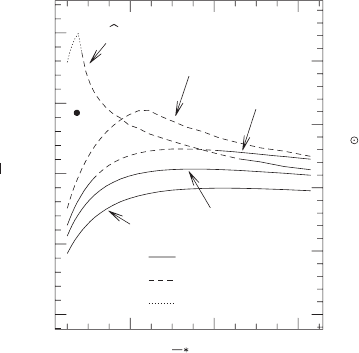Baumgarte T., Shapiro S. Numerical Relativity. Solving Einstein’s Equations on the Computer
Подождите немного. Документ загружается.


14.1 Initial data: equilibrium models 461
where the metric potentials ρ, γ , ω,andσ are functions of r and θ only. We shall take
the matter source to be described by a stress-energy tensor T
ab
, which, for the moment,
we shall leave unspecified, to allow for generalization to alternative matter sources.
8
The
stellar model satisfies the Einstein field equations G
ab
= 8π T
ab
. These can be arranged to
yield elliptic equations to determine ρ, γ and ω:
∇
2
[ρe
γ/2
] = S
ρ
(r,µ), (14.2)
∇
2
+
1
r
∂
r
−
µ
r
2
∂
µ
[γ e
γ/2
] = S
γ
(r,µ), (14.3)
∇
2
+
2
r
∂
r
−
2µ
r
2
∂
µ
[ωe
(γ −2ρ)/2
] = S
ω
(r,µ), (14.4)
where ∇
2
is the flat-space scalar Laplacian in spherical polar coordinates, µ = cos θ,and
S
ρ
, S
γ
and S
ω
are effective source terms that include the nonlinear field and matter terms.
The effective source terms are given in Appendix G. The fourth field equation for σ is
slightly more complicated and is also listed in Appendix G.
The three elliptical field equations (14.2)–(14.4) can be solved by an integral Green
function approach, as shown by KEH. Among the attractive features of this approach is
that, for large r, the asymptotic flatness conditions ρ ∝ 1/r, γ ∝ 1/r
2
and ω ∝ 1/r
3
are
imposed automatically. The integral equations for these functions are given in Appendix G.
Auxiliary relations associated with the matter are discussed below.
14.1.2 Fluid stars
For perfect fluid stars the stress-energy tensor is given by equation (5.4),
T
ab
= ρ
0
hu
a
u
b
+ Pg
ab
. (14.5)
The coordinate components of the 4-velocity of the matter can be written as
u
a
= u
t
[1, 0, 0,], u
t
=
e
−(ρ+γ )/2
(1 − v
2
)
1/2
, (14.6)
where is the angular velocity of the matter as measured at infinity, and v is the proper
velocity of the matter with respect to a normal observer, often referred to as a “zero angular
momentum observer” or ZAMO
9
in the literature dealing with rotating equilibria,
v = ( − ω)r sin θ e
−ρ
. (14.7)
Exercise 14.1 Derive equation (14.7).
Hint: Compute γ
v
≡ (1 − v
2
)
−1/2
from γ
v
=−u
a
n
a
.
8
Shapiro and Teukolsky (1993a,b).
9
Bardeen (1973).

462 Chapter 14 Rotating stars
The condition ∇
a
T
a
b
= 0 yields the equation of hydrostatic equilibrium, which can be
written in differential form as
dP − ρ
0
h[d ln u
t
− u
t
u
φ
d] = 0. (14.8)
Exercise 14.2 Derive equation (14.8).
The final relation required to specify an equilibrium configuration is the rotation law.
For barotropic equations of state where P and h depend only on ρ
0
, the integrability
condition on equation (14.8) requires either that the rotation be uniform, with d = 0, or
that
u
t
u
φ
= F() (14.9)
for some function F of . In the latter case the configuration is characterized by differential
rotation. A simple choice adopted by KEH is
F() = A
2
(
c
− ), (14.10)
where
c
is the angular velocity at the center of the configuration and A is a positive
constant with dimensions of length. Combining equations (14.9) and (14.10) yields
A
2
(
c
− ) =
( − ω)r
2
sin
2
θe
2(β−ν)
1 − ( − ω)
2
r
2
sin
2
θe
2(β−ν)
, (14.11)
where, following convention, we have introduced
ν ≡
γ + ρ
2
and β ≡
γ − ρ
2
. (14.12)
Equation (14.11) shows that the angular velocity on the rotation axis (θ = 0) is equal to
c
.AsA →∞,wehave →
c
, hence for large A the rotation law approaches rigid
rotation. Exercise 14.3 further illustrates how A parameterizes the characteristic length
scale over which changes.
Exercise 14.3 Show that in the Newtonian limit, rotation law (14.11) reduces to
/
c
= 1/
1 + !
2
/A
2
, (14.13)
where ! = rsin θ is the usual cylindrical radial coordinate.
Using the thermodynamic relation dh = dP/ρ
0
together with equation (14.9), allows
us to integrate the equation of hydrostatic evolution (14.8) to obtain
ln
h
u
t
=−
dF() + constant. (14.14)
Adopting the rotation law (14.11)thengives
ln
h
u
t
=
1
2
A
2
( −
c
)
2
+ constant. (14.15)

14.1 Initial data: equilibrium models 463
For a polytropic equation of state (EOS) P = Kρ
(1+1/n)
0
, as in equation (1.86),
10
equa-
tions (14.6) and (14.15) yield
ln[1 + (1 + n)Kρ
1/n
0
] +
1
2
ln(1 − v
2
) + ν −
1
2
A
2
( −
c
)
2
= constant. (14.16)
Note that when using a polytropic EOS, it is always possible to scale out the constant K .
We already noted this in Chapter 1.3 (see equation 1.87), but here we extend the analysis
to nonspherical, rotating polytropes. In gravitational units K
n/2
has units of length, which
leads to the following set of nondimensional quantities, denoted by a bar:
¯
r ≡ K
−n/2
r,
¯
t ≡ K
−n/2
t, ¯ω ≡ K
n/2
ω,
¯
≡ K
n/2
,
¯ρ
0
≡ K
n
ρ
0
,
¯
P ≡ K
n
P,
¯
M ≡ K
−n/2
M,
¯
J ≡ K
−n
J, (14.17)
and so forth. One can thus set K = 1 in numerical integrations and either use the above
relations to scale the results to more physical values of K , or express answers in terms of
nondimensional ratios (e.g., R/M, M
2
ρ
0
, M, J/M
2
,etc.).
11
The iterative algorithm of KEH to solve the coupled equations involves a further rescal-
ing with respect to the equatorial radius
¯
r
e
= K
−n/2
r
e
. This rescaling simplifies the numer-
ical implementation, since the unknown location of the stellar surface in the equatorial
direction can now be set to unity. We can then parametrize the stellar rotation rate by
setting the polar radius
¯
r
p
/
¯
r
e
to a value equal or less than unity: for
¯
r
p
/
¯
r
e
= 1thestaris
spherical and nonrotating, and decreasing this ratio (for oblate configurations) will increase
the angular velocity
¯
. Once all quantities have been expressed in terms of
¯
r
e
, this quan-
tity appears as an eigenvalue in equation (14.16), together with
c
and the constant on
the right-hand side. A self-consistent solution of Einstein’s field equations coupled to the
matter equation (14.16) then involves determining these three eigenvalues. This can be
accomplished by evaluating equation (14.16), given a “guess” for the gravitational fields,
at three different locations in the star, namely at the pole, on the equator, and at the stellar
center, and then iterating until convergence. We will describe a similar algorithm for the
construction of binary neutron star initial data in more detail in Chapter 15.2.
Diagnostics
Once the coupled system of equilibrium equations is solved self-consistently, a useful set
of physical diagnostics can be computed for each configuration. For equilibrium config-
urations, the ADM mass must be equal to the Komar mass (see Chapter 3.5). We may
therefore define the total mass-energy M = M
ADM
of these spacetimes as
M = M
K
=−
(2T
a
b
− δ
a
b
T
c
c
)ξ
b
(t)
d
3
a
=
(−2T
t
t
+ T
c
c
)
√
γαd
3
x (14.18)
10
Note that KEH adopt a different definition of a polytropic EOS: P = Kρ
∗(1+1/n)
,whereρ
∗
= ρ
0
(1 +). Other authors
(e.g., Cook et al. 1992, 1994a,b), use equation (5.18). As a result, equation (14.16) is modified for KEH.
11
See exercises 14.4, 14.5 and 14.6 for examples.

464 Chapter 14 Rotating stars
(see exercise 3.31). Here d
3
a
is defined below equation (3.124), and ξ
b
(t)
is the time Killing
vector. The total rest-mass M
0
isgivenbyequation(3.127),
M
0
=
ρ
0
u
a
d
3
a
=
ρ
0
√
γαu
t
d
3
x. (14.19)
The total proper mass of the system M
p
is defined as the rest-mass energy M
0
plus internal
energy U of the star, i.e., the total energy stored in the configuration excluding gravitational
potential and rotational energy,
M
p
= M
0
+ U, (14.20)
where
U =
ρ
0
u
a
d
3
a
=
ρ
0
√
γαu
t
d
3
x. (14.21)
The total angular momentum of the system J is given by
J =
T
a
b
ξ
b
(φ)
d
3
a
=
T
t
φ
√
γαd
3
x, (14.22)
where ξ
b
(φ)
is the angular Killing vector (see exercise 3.31). The total rotational kinetic
energy of the system T is defined by
T =
1
2
dJ =
1
2
T
t
φ
√
γαd
3
x. (14.23)
Finally, we can compute the gravitational potential energy of the star W as
W = M − M
p
− T. (14.24)
All of the above integral diagnostics are gauge invariant quantities that reduce to their
Newtonian counterparts in the weak-field limit.
Maximum masses, spins and stability
Numerical models of rotating stars obtained by solving the equilibrium equations have been
constructed by many authors.
12
Equilibrium sequences constructed for a given barotropic
EOS, along which either the rest mass or angular momentum is held constant, are particu-
larly useful. Constant rest-mass sequences often can be used to represent quasistationary
evolutionary sequences, along which some parameter, like the angular velocity, varies
slowly, on a secular time scale. Along a uniformly rotating, equilibrium sequence of
constant M
0
, changes in M and J are related by
13
dM = dJ. (14.25)
12
See, e.g., footnote 7 for detailed model calculations in general relativity. For overviews and additional references
concerning rotating equilibria and stability, see, e.g., Tassoul (1978) for Newtonian configurations and Shapiro and
Teukolsky (1983) and Stergioulas (2003) for post-Newtonian and general relativistic configurations.
13
See Ostriker and Gunn (1969) for a proof in the Newtonian case and Hartle (1970) for the relativistic case.

14.1 Initial data: equilibrium models 465
This relation provides a useful check on the numerical construction of such a sequence.
Equilibrium sequences of constant J are required in order to apply the turning-point
criterion of Friedman, Ipser and Sorkin
14
to test for quasiradial stability of a uniformly
rotating configuration. This criterion states that along uniformly rotating sequences of
constant J , members of which can be parametrized by their central mass-energy density
ρ
∗
c
= ρ
0c
(1 +
c
), those configurations for which ∂ M/∂ρ
∗
c
> 0 are secularly stable against
quasiradial perturbations, while those for which ∂ M/∂ρ
∗
c
< 0 are secularly unstable. The
turning point criterion applied along such sequences can only identify the point of secular,
but not dynamical, instability, since one is comparing neighboring, uniformly rotating
configurations with the same angular momentum. Maintaining uniform rotation during
perturbations tacitly assumes high viscosity, which acts on a secular time scale. In a
dynamical perturbation, the star will preserve circulation, as well as angular momentum,
but not uniform rotation. While a secular instability evolves on a dissipative (e.g., viscous)
time scale, a dynamical instability evolves on a collapse (free-fall) time scale, τ
ff
∼1/
√
ρ
∗
,
which is much shorter. It is thus possible that a secularly unstable star may be dynamically
stable: for sufficiently small viscosity, the perturbed star may change to a differentially
rotating, dynamically stable configuration. Ultimately, the presence of viscosity may bring
the star back into rigid rotation, driving the star to an unstable state. Friedman, Ipser
and Sorkin showed that along a sequence of uniformly rotating stars, a secular instability
always occurs before a dynamical instability, implying that all secularly stable stars are
also dynamically stable.
For spherical star sequences, the points of onset of secular and dynamical instability
coincide, since for a nonrotating star a radial perturbation conserves both circulation
and uniform rotation, and is located at the turning point on the M vs. ρ
∗
c
equilibrium
curve. This result suggests that for uniformly rotating stars for which the rotational kinetic
energy T is typically a small fraction of the gravitational binding energy |W |, the onset of
dynamical instability is close to the onset of secular instability. Establishing the actual point
of onset of dynamical instability for rotating stars is more complicated. Formalisms have
been developed
15
to identify points of dynamical instability to axisymmetric perturbations
along sequences of rotating stars. In such formalisms, however, a complicated functional
for a set of trial functions has to be evaluated. Probably because of the complexity of
this method, explicit calculations have never been performed. In practice, to identify the
point of onset of a dynamical instability along an equilibrium sequence of uniformly or
differentially rotating stars, and then to track the resulting evolution and determine the final
fate of an unstable configuration, a full numerical simulation employing the equilibrium
model as initial data is required. That is the role of numerical relativity (see Section 14.2).
Nonrotating polytropes with n = 3or = 1 + 1/n = 4/3 are marginally stable to radial
perturbations in Newtonian gravitation, but dynamically unstable in general relativity. The
14
Friedman et al. (1988).
15
Chandrasekhar and Friedman (1972a,b,c); Schutz (1972).

466 Chapter 14 Rotating stars
critical for radial stability for nonrotating stars is raised above 4/3 in general relativity,
16
crit
= 4/3 + 1.125(M/R). Stars with >
crit
are stable, while those with <
crit
are unstable. Post-Newtonian analysis shows that unstable stars with near 4/3 can be
stabilized by rotation, which lowers the critical value of . Alternatively, there is a critical
compaction (M/R)
crit
below which a rotating star with n = 3 is radially stable and above
which it is unstable. The critical compaction depends on T/|W |, the ratio of rotational
kinetic to gravitational binding energy. Determining the critical compaction for uniformly
rotating stars with n ≈ 3 requires an analysis correct to second post-Newtonian order.
17
Uniformly rotating stars at the mass-shedding limit (defined below) with n near 3 are useful
to model rapidly rotating configurations supported either by the pressure of relativistic
degenerate fermions (e.g., massive white dwarfs or cores of massive, evolved stars) or by
thermal radiation pressure (e.g., very massive and supermassive stars).
18
The maximum mass of a relativistic star, like a neutron star, is of great astrophysical
interest. Configurations exceeding the maximum mass limit are likely to collapse to form
black holes. For spherical (static) stars constructed from the same barotropic EOS, the
maximum mass is located at the turning point along the M vs. ρ
∗
c
equilibrium curve and is
thus marginally stable to quasiradial perturbations. Rotation can support stars with higher
mass than the maximum static limit. Thus, uniform rotation can support these supramassive
stars, but Cook et al. (1992, 1994a,b, hereafter CST) show that supramassive stars have
masses which are typically at most
<
∼
20% larger than the static limit for the same EOS.
In Table 14.1 we compare maximum mass models for nonrotating and uniformly rotating
polytropes.
19
Beyond a critical spin rate, the gravitational attraction is insufficient to keep
matter in uniform rotation from flying off the surface. At the so-called mass-shedding
limit, matter at the equator has no outward support from pressure but is instead supported
exclusively by centrifugal forces and therefore follows a circular geodesic. CST find that for
a given EOS, the maximum configuration (i.e., the configuration at the mass-shedding
limit) does not coincide exactly with the maximum mass model, although they are quite
close numerically.
Exercise 14.4 Consider modeling the EOS of a neutron star by a degenerate,
nonrelativistic, neutron gas. Such a gas is described by a polytropic EOS with
n = 3/2and
K =
3
2/3
π
4/3
5
¯
h
2
m
8/3
n
, (14.26)
where m
n
is the neutron rest-mass.
20
16
Chandrasekhar (1964a,b); Feynmann, unpublished, as quoted in Fowler (1964).
17
Zeldovich and Novikov (1971); Baumgarte and Shapiro (1999).
18
See Baumgarte and Shapiro (1999); Shibata (2004) for numerical models.
19
See, e.g., Cook et al. (1994a) for uniformly rotating models, including maximum-mass models, constructed for 14
realistic nuclear matter EOSs.
20
See Shapiro and Teukolsky (1983), Section 2.3, for a derivation.

Table 14.1 Maximum mass models for nonrotating and uniformly rotating polytropes. For all stars we list the the polytropic index n,
the total mass-energy
¯
M, the rest-mass
¯
M
0
and the central energy density ¯ρ
∗
c
. For nonrotating stars we also list the areal radius
¯
R,
while for rotating stars we give the equatorial areal radius
¯
R
e
, the eccentricity e, the angular velocity measured at infinity
¯
, the total
angular momentum
¯
J and the ratio of the rotational kinetic energy to the gravitational binding energy, T /|W |. All quantities are
expressed in nondimensional units as defined in equation (14.17) (with G = c = 1). Here the notation 5.80(−3), for example, means
5.80 × 10
−3
. [After Cook et al. (1994a).]
Nonrotating Rotating
n
¯
M
¯
M
0
¯
R ¯ρ
∗
c
¯
M
¯
M
0
¯
R
e
e ¯ρ
∗
c
¯
¯
JT/|W |
0.5 0.125 0.151 0.395 1.29 0.153 0.182 0.536 0.784 1.04 0.976 0.0172 0.147
1.0 0.164 0.180 0.763 0.420 0.188 0.207 1.09 0.773 0.345 0.378 0.0202 0.0835
1.5 0.264 0.276 1.97 0.0718 0.290 0.304 2.88 0.760 0.0610 0.110 0.0387 0.0475
2.0 0.515 0.523 6.94 5.80(−3) 0.549 0.558 10.3 0.752 5.05(−3) 0.0224 0.120 0.0273
2.5 1.24 1.25 41.0 1.26(−4) 1.29 1.30 61.3 0.749 1.13(−4) 2.37(−3) 0.684 0.0157
2.9 3.23 3.23 620 1.54(−7) 3.32 3.32 947 0.749 1.38(−7) 6.36(−5) 7.82 0.0101
468 Chapter 14 Rotating stars
(a) Show that, in geometrized units, K = 7.327 km
4/3
. Note that K
n/2
has units
of length, consistent with the scaling relations (14.17).
(b) Consult Table 14.1 anduseequation(14.17) to find the maximum mass of
nonrotating and uniformly rotating stars governed by this EOS. Given that many
neutron stars are observed to have a mass close to 1.4M
, is this EOS realistic?
Exercise 14.5 The polytropic index n parametrizes the stiffness of the polytropic
EOS. Smaller values of n (and hence larger values of = 1 + 1/n) describe stiffer
EOSs, while larger values of n (smaller ) describe softer EOSs. Stars governed
by soft EOS are centrally condensed, i.e., most of the star’s mass is concentrated in
a small, high-density core surrounded by an extended, low-density envelope. Stiff
EOSs, on the other hand, lead to stars that have a more uniform density profile.
(a) Compute the compaction M/R for the nonrotating maximum mass models
listed in Table 14.1. Use your results to justify using a stiff polytropic EOS with
n 1 to model typical neutron stars with masses M ≈ 1.4M
and radii R ≈ 15 km.
(b) Compute the fractional difference between M and M
0
for the nonrotating
models of Table 14.1. Explain its dependence on n in terms of the results for M/R
in part (a).
(c) Compute the fractional increase in the rest-mass M
0
between the nonrotating
and uniformly rotating maximum mass models listed in Table 14.1. Explain its
dependence on n in terms of the central concentration of these stars.
Exercise 14.6 PSR J1748−2446ad, with a spin frequency of f = 716 Hz, is the
most rapidly spinning pulsar known to date.
21
(a) Assume that the mass of this pulsar is at least 1.4M
to find a lower limit on
the dimensionless product M for this pulsar.
(b) Now survey Table 14.1, assuming that the angular velocities of the maximum
mass models listed there are very close to the maximum spin models, to find which
values of n can support a star like PSR J1748−2446ad.
By contrast with uniform rotation, differential rotation, can support hypermassive stars,
i.e., equilibrium stars which exceed both the nonrotating static and uniformly rotating
supramassive star mass limits. As an example, consider the rotation law given by equa-
tion (14.10) with
ˆ
A ≡ A/R
e
,whereR
e
is the equatorial coordinate radius, and apply it to
an n = 1 polytrope.
22
Figure 14.1 shows the maximum M
0
vs. ρ
∗
c
relation along sequences
of constant
ˆ
A. It is clear from the figure that even modest differential rotation can sup-
port equilibrium stars with masses
>
∼
50% larger than the static and supramassive limits.
23
Hypermassive neutron stars can be formed in nature, by, e.g., merging binary neutron stars
or by stellar core collapse followed by accretion fall-back.
Exact criteria do not exist for determining the quasiradial stability of differentially
rotating configurations, either to dynamical or secular perturbations. Such stability must be
determined by numerical simulations. In Section 14.2 we discuss such simulations, which
21
See Hessels et al. (2006).
22
Baumgarte et al. (2000).
23
For most other polytropic indices, as well as for realistic nuclear EOSs, the increases in maximum mass are typically
somewhat smaller; see Lyford et al. (2003); Morrison et al. (2004).

14.1 Initial data: equilibrium models 469
0
0
0.5
0.7
A
−1
=1.0
0.14<b<0.27
TOV
b<0.14
b>0.27
r
max
0.2 0.4 0.6
0
1
2
3
4
0.4
0.3
0.2
M
0
M
0
/M
0.1
Figure 14.1 Maximum rest-mass configurations vs. maximum mass-energy density for differentially rotating
n = 1 sequences of constant
ˆ
A
−1
.Valuesofβ = T/|W | for the models are indicated. The mass–density curve
for static TOV equilibrium stars is shown for comparison. The supramassive limit for uniformaly rotating stars
corresponds to the curve
ˆ
A
−1
= 0. Masses are given in nondimensional units on the left-hand side (K = 1) and
in solar masses on the right-hand side; the later are calculated by assigning the maximum rest mass for
nonrotating stars to 2M
. The dot marks one particular hypermassive configuration whose stability properties we
will study below. [From Baumgarte et al. (2000).]
reveal, for example, that the hypermassive configuration marked by a dot in Figure 14.1
is dynamically stable. On the other hand, the presence of viscosity or magnetic fields will
redistribute the angular momentum in a differentially rotating star on a secular time scale,
presumably driving its core toward uniform rotation while depositing the excess angular
momentum in the outermost layers. But uniform rotation alone cannot support such a
core in equilibrium, if it is sufficiently massive. As a result, most, if not all, hypermassive
stars are transient objects: configurations that are dynamically stable initially will evolve
on a secular time scale and may ultimately undergo catastrophic collapse. Relativistic
simulations that demonstrate this behavior are described in Section 14.2.
In addition to quasiradial instabilities, rotating stars are also subject to nonaxisymmetric
instabilities. An exact treatment of these instabilities exists only for incompressible equilib-
rium fluids in Newtonian gravity.
24
For these configurations, global rotational instabilities
arise from nonradial toroidal modes e
imϕ
(m =±1, ±2,...) when β ≡ T /|W | exceeds a
certain critical value. Here ϕ is the azimuthal coordinate. In the following we will focus on
the m =±2 bar mode, since it is the fastest growing mode when the rotation is sufficiently
rapid.
25
24
See, e.g., Chandrasekhar (1969); Tassoul (1978); Shapiro and Teukolsky (1983).
25
For a discussion of the r -mode instability, which may be important for slowly rotating neutron stars, see Stergioulas
(2003) for review and references.
470 Chapter 14 Rotating stars
There exists two different mechanisms and corresponding timescales for bar-mode
instabilities. Uniformly rotating, incompressible stars in Newtonian theory are secularly
unstable to bar-mode formation when β ≥ β
s
≥ 0.1375. However, this instability can only
grow in the presence of some dissipative mechanism, like viscosity or gravitational radia-
tion reaction, and the growth time is determined by the dissipation time scale. Interestingly,
for either viscosity or gravitational radiation, the point of onset of the bar-mode instability
coincides for Newtonian stars. By contrast, a dynamical instability to bar-mode formation
requires large spin rates and sets in when β ≥ β
d
≥ 0.2738. This instability is independent
of any dissipation mechanism, and the growth time is determined by the hydrodynamical
(collapse) time scale of the system.
In the case of compressible Newtonian stars, the secular bar-mode instability for both
uniform and differential rotation has been analyzed numerically within linear perturbation
theory by means of a variational principle and trial functions, and by other approximate
means.
26
For uniformly rotating polytropes the m = 2 bar-mode instability is again found
to set in at β
s
0.14.
27
However, this mode is reached only when the polytropic index of the
star satisfies n ≤ 0.808.
28
Stars with larger n (i.e., soft EOSs) are too centrally condensed
to support high enough spin in uniform rotation without undergoing mass-shedding at the
equator. This constraint does not apply to differentially rotating stars, which can support
significantly more rotational energy in equilibrium, even when the degree of differential
rotation is only moderate. The critical value for the onset of the secular m = 2 bar mode in
Newtonian theory is again β
s
0.14 for a wide range of angular momentum distributions
and barotropic equations of state
29
although for very strongly differentially rotating stars
the critical value can be as small as β
s
< 0.1.
30
Similar approximate formalisms have also been applied to analyze the secular bar-mode
instability in post-Newtonian theory
31
and in full general relativity.
32
For relativistic stars,
the critical value of β
s
depends on the compaction M/R of the star, the rotation law and
the dissipative mechanism. The gravitational-radiation driven instability sets in for smaller
rotation rates than in Newtonian theory, i.e., it is triggered for values of β
s
< 0.14 as the
compaction increases. By contrast, viscosity drives the instability to higher rotation rates
β
s
> 0.14 as the configurations become more compact.
Determining the onset of the dynamical bar-mode instability, as well as the subse-
quent evolution of an unstable star, generally requires a numerical simulation. Simulations
performed in Newtonian theory
33
have shown that β
d
depends only very weakly on the
stiffness of the EOS. Once a bar has developed, the formation of spiral arms plays an
26
Lynden-Bell and Ostriker (1967); Ostriker and Bodenheimer (1973); Friedman and Schutz (1975); Bardeen et al.
(1977); Friedman and Schutz (1978a,b); Ipser and Lindblom (1989).
27
See, e.g., Managan (1985); Imamura et al. (1985); Ipser and Lindblom (1990, 1991); Lai et al. (1993a).
28
James (1964).
29
See, e.g., Ostriker and Bodenheimer (1973); Bardeen et al. (1977); Tassoul (1978).
30
Imamura et al. (1995).
31
Cutler and Lindblom (1992); Shapiro and Zane (1998).
32
Bonazzola et al. (1996); Stergioulas and Friedman (1998).
33
See, e.g., Tohline et al. (1985); Smith et al. (1996); Pickett et al. (1996); New et al. (2000) and references therein.
